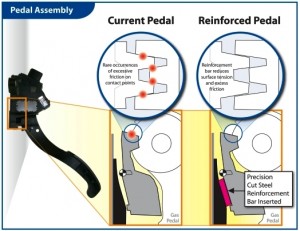For us old war dogs of the car safety wars, there were few surprises in the opening round of Congressional hearings today about alleged Toyota safety problems.
Certainly, the predictable appearance of a “surprise” adversarial witness, Professor David W. Gilbert of Southern Illinois University, should have come as no political game upset, especially since it was telegraphed the night before by his appearance on ratings-driven ABC Television.
Gilbert, who is listed on the SIU website as an associate professor in the Department of Automotive Technology, College of Applied Science and Arts of the Carbondale campus, excoriated Toyota’s design of its electronic throttle mechanism. He claimed to have tricked the system into demonstrating the possibility of runaway acceleration from a simple short circuit.
Toyota denied his claim. No surprise in the denial—what other response could they make?
I think Gilbert is taking on a big load, challenging the expertise of veteran Toyota engineers – and perhaps that of suppliers as well.
He may be right – but if he is wrong – it could be a maliciously staged bit of mischief by ABC-TV or – who knows what?
It would not be the first time that a network TV news department has participated in tests or interviews intended to embarrass and otherwise harm an auto company. Anybody remember the rigged fuel tank fire in a GM pickup truck a few years ago that cost the head of NBC news his job?
One wonders just how Gilbert came to testify before this Congressional Committee?
- Has he been a professional witness in lawsuits against auto companies?
- How solid are his credentials?
- Is it possible he had help on his testimony from a third party with commercial interest in the outcome of Toyota’s discomfort?
These are questions needing answers as the Toyota controversy continues. But don’t look for pandering politicians to provide them.
We have just learned that Gilbert is connected with professional witness – for profit, of course – Sean Kane, recognized by some as a safety gadfly successor to Ralph Nader.
The irony is, of course, that it is doubtful if anyone in the Committee Hearing room had the foggiest idea about what Gilbert testified – other than it made Toyota look bad – especially the congresspersons in attendance, who are up for reelection, and the members of the news media honing their knives.
The testimony was larded with acronyms (“ETC” for electronic throttle control was the least of them) requiring even a careful and fairly knowledgeable reader to search for clarifications.
On the other hand, suppose Gilbert is correct that there is a hidden defect, one that Toyota didn’t anticipate in the way its engineers designed the EDC system?
Or worse yet, that they did anticipate, but did not make it “fool proof.”
I’m more than bothered by the fact Toyota chose to cut corners on its “black box” Electronic Data Recorders (EDRs), by not matching the depth of recorded data that GM and Ford have had in their black boxes for years.
Black box data is critically important in reconstructing crashes to determine causes.
What could possibly be Toyota’s motive for going cheap on this?


The whole Toyota thing appears to be an engineered or oppertunistic distraction to keep the public occupied while washington rams and jams it’s unpopular agenda out of sight.
Toyota’s problems can be predicted by what GM delt with 40 years ago. 1969-70, rusting frames on fiull sized cars. 1970-71,unintended acceleration caused by motor mounts.1972-73, unintended acceleration caused by plastic idle cam failure. All driven by rapidly expanded production.
Dan,
Sorry, I’ve got to firmly disagree.
Now, if you said that there was a serious amount of grandstanding, this week, by members of the Congressional committees investigating Toyota, I’d have accepted that…while adding that there were some serious and critical moments, as well – such as when Jim Lentz, Toyota’s top American executive, pointedly acknowledged the 2 recalls for unintended acceleration probably address only about 30% of the complaints received.
I’ve been covering this business nearly as long as you refer to, but while there’s no question that serious misbehavior can be found in the past, we’ve seen a lot of change, in recent decades, with Toyota proudly waving its own flag and insisting it led the charge.
What we now see, instead, is a company desperate to be #1 that has potentially abandoned everything it stood for. Today, the allegations against Toyota are intolerable.
I was deeply involved in our research on the Prius braking issue and that has raised serious questions in my mind. But worse is the strong possibility that still further recall(s) for earlier models may occur — just as we could very well see more actions on unintended acceleration — and Corolla steering, and Corolla and Matrix stalling, and so on.
The transition from benchmark and paragon to apparent pariah is not “manufactured.” Nor is the situation over.
Yes, we’ll continue to see grandstanding, and yes, even some members of the media are joining in. But there’s a good reason why Toyota is now under the microscope.
Paul A. Eisenstein -TheDetroitBureau.com